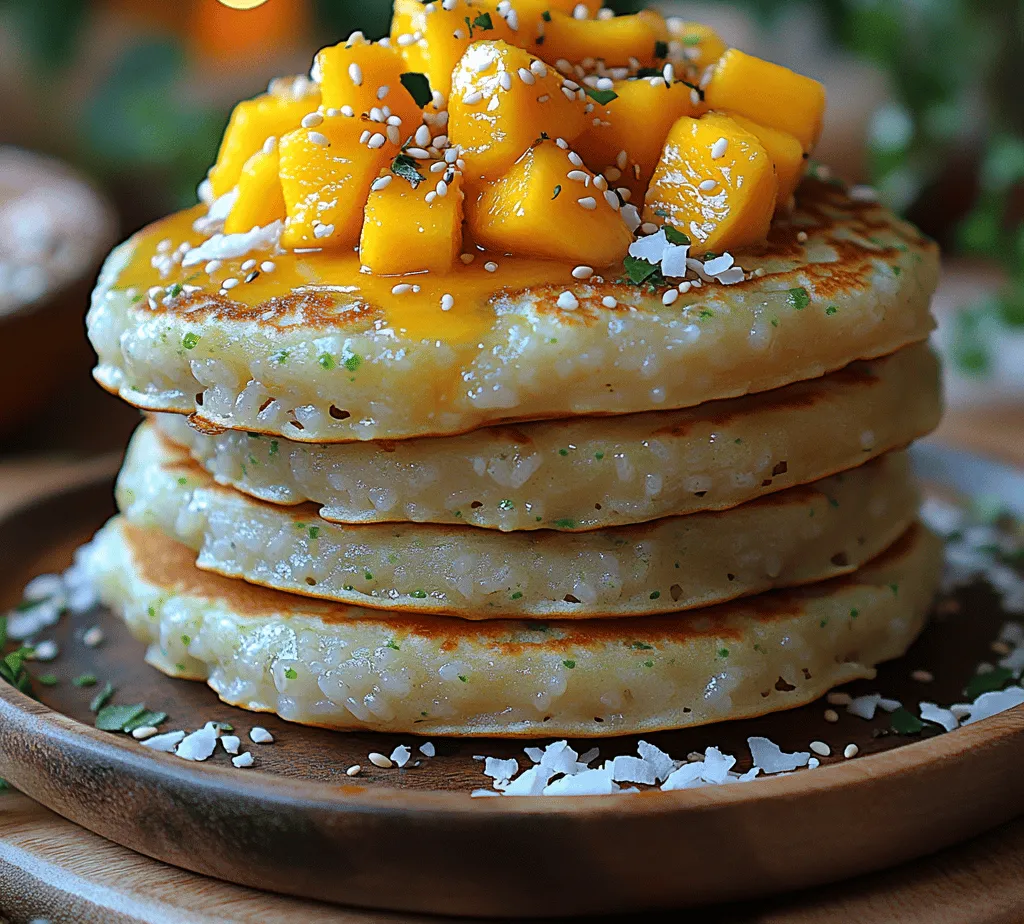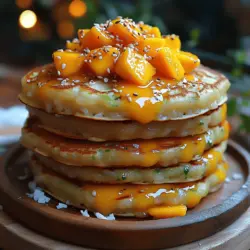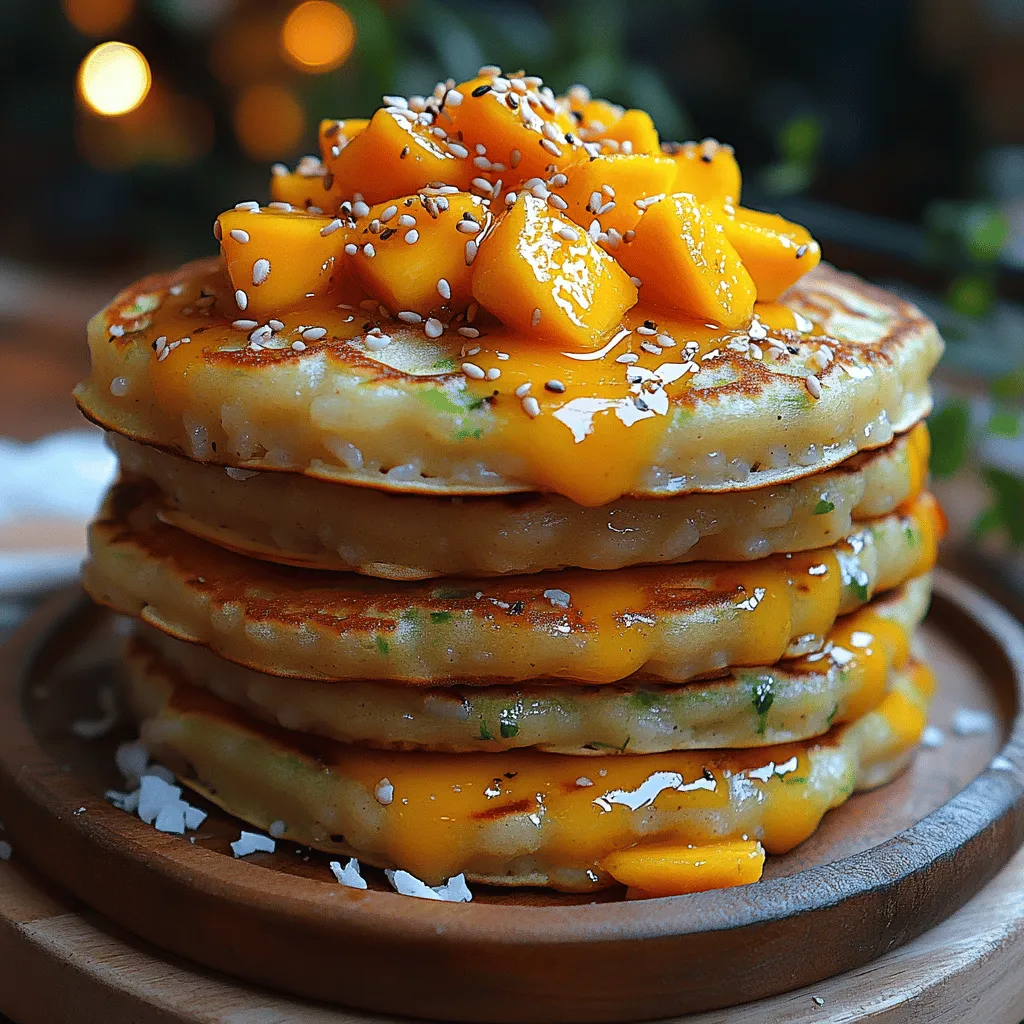Embark on a delightful culinary journey with our fusion recipe for Mango Sticky Rice Pancakes. This unique twist on the traditional Thai dessert marries the rich, comforting flavors of glutinous rice and coconut with fresh, juicy mangoes, creating a memorable breakfast or brunch experience that will tantalize your taste buds. Whether you’re a seasoned chef or a curious beginner, the process of making these pancakes is both fun and fulfilling. In this article, we will guide you through every step of the recipe, sharing insights into the ingredients, cooking techniques, and the cultural significance behind this dish.
Understanding the Key Ingredients
To create the perfect Mango Sticky Rice Pancakes, it’s essential to understand the role of each ingredient. Each component not only contributes to the flavor and texture but also reflects the cultural heritage of Thai cuisine.
Glutinous Rice Flour
At the heart of these pancakes is glutinous rice flour, which is made from short-grain sticky rice. Unlike regular rice flour, glutinous rice flour is finely milled and has a higher starch content, which gives the pancakes their characteristic chewy texture. This flour is a staple in many Southeast Asian desserts and is essential for achieving that signature stickiness and softness that mimics traditional mango sticky rice.
All-Purpose Flour
While glutinous rice flour provides that unique chewiness, all-purpose flour plays a crucial role in balancing the density. By incorporating all-purpose flour into the pancake batter, you ensure a lighter texture that makes the pancakes easier to flip and cook evenly. This blend of flours is what makes each bite a delightful experience, combining soft and chewy elements with a light, fluffy base.
Coconut Milk
Coconut milk is another key ingredient that adds creaminess and a rich tropical flavor to the pancakes. It is derived from the flesh of mature coconuts and is a fundamental component in many Thai dishes. In these pancakes, coconut milk not only enhances the flavor but also contributes to the moisture needed for the batter, ensuring that each pancake remains tender and delectable.
Ripe Mango
No Mango Sticky Rice Pancakes would be complete without the star topping: ripe mango. Known for its vibrant color and sweet, juicy flesh, mango provides a fresh contrast to the rich and creamy pancakes. When selecting mangoes, aim for those that are slightly soft to the touch and have a fragrant aroma. The natural sweetness of ripe mangoes elevates this dish, making it not just a breakfast item but a delightful treat any time of the day.
Coconut Cream
To enhance the creaminess of the mango topping, coconut cream is often drizzled over the finished pancakes. This thick, luscious cream is made from the same coconuts as coconut milk but contains a higher fat content, resulting in a richer flavor. Coconut cream adds an extra layer of indulgence to the pancakes and ties all the flavors together, creating a harmonious balance between sweet, creamy, and chewy components.
The Culinary Fusion of Cultures
Mango Sticky Rice, known as “Khao Niew Mamuang” in Thai, is a traditional Thai dessert that has its roots in Southeast Asian cuisine. It typically consists of glutinous rice cooked in sweetened coconut milk, served alongside slices of ripe mango, and garnished with a drizzle of coconut cream and a sprinkle of mung beans or sesame seeds.
Origins in Southeast Asian Cuisine
The origins of mango sticky rice can be traced back to the rich agricultural landscape of Thailand and neighboring countries, where mangoes thrive in abundance during the warmer months. The dish is often enjoyed during the mango season, which peaks between April and June, and is a popular choice for festive celebrations and family gatherings. The combination of sweet and savory flavors, along with the contrasting textures, showcases the culinary ingenuity of Thai chefs and home cooks alike.
Modern Adaptations and Its Rise in Global Popularity
In recent years, mango sticky rice has gained international acclaim, becoming a beloved dessert in Thai restaurants around the world. Its unique flavor profile and beautiful presentation have inspired countless adaptations, with creative chefs experimenting with various formats and presentations. The transformation of this traditional dessert into pancakes is just one example of how cultural fusions can lead to exciting new culinary experiences.
With the rising trend of brunch culture, the Mango Sticky Rice Pancakes have emerged as a delightful option that combines the essence of a classic dessert with the comfort of breakfast food. This fusion not only introduces the flavors of Thailand to a wider audience but also invites everyone to explore the joy of cooking and sharing delightful meals.
Step-by-Step Guide to Making Mango Sticky Rice Pancakes
Crafting the perfect Mango Sticky Rice Pancakes involves several steps, from preparing the pancake batter to cooking and serving the pancakes. Below, we outline the initial steps to ensure that your pancakes turn out perfectly every time.
Preparing the Pancake Batter
The first step in creating delicious Mango Sticky Rice Pancakes is preparing the batter. This process is straightforward but requires attention to detail to achieve a smooth consistency.
1. Mixing Dry and Wet Ingredients: Start by combining the glutinous rice flour and all-purpose flour in a mixing bowl. Whisk them together to ensure an even distribution of the two flours. In a separate bowl, mix the coconut milk and any other wet ingredients, such as eggs if you’re using them. Whisk these together until well combined.
2. Combining Ingredients: Gradually pour the wet mixture into the bowl with the dry ingredients. Using a whisk or a spatula, gently mix the ingredients until just combined. Be careful not to over-mix, as this can lead to tough pancakes. Aim for a slightly lumpy batter, which is an indicator that you haven’t overworked the mixture.
3. Importance of Resting the Batter: Once mixed, let the pancake batter rest for about 20 to 30 minutes. This resting period allows the flours to hydrate fully, resulting in a better texture. It also helps to relax the gluten in the all-purpose flour, making the pancakes softer and fluffier.
Cooking the Pancakes
After the batter has rested, it’s time to cook the pancakes. This step can be fun and rewarding as you watch your efforts transform into delicious pancakes.
1. Choosing the Right Skillet or Griddle: A non-stick skillet or griddle is ideal for cooking pancakes. If you don’t have a non-stick option, be sure to grease your pan with a bit of oil or cooking spray to prevent sticking. Preheat the skillet over medium heat, ensuring it is hot but not smoking.
2. Pouring the Batter: Once the skillet is ready, pour a ladleful of the batter onto the skillet. Use the back of the ladle to gently spread the batter into a circle, about 4 to 5 inches in diameter.
3. Cooking Until Golden-Brown: Allow the pancake to cook for about 2 to 3 minutes, or until small bubbles begin to form on the surface. This is a sign that the pancake is ready to be flipped. Carefully flip the pancake using a spatula and cook for an additional 1 to 2 minutes on the other side, until golden brown.
4. Stacking and Serving: As you cook each pancake, transfer them to a warm plate and cover them with a clean kitchen towel to keep them warm until all pancakes are ready. Serve your Mango Sticky Rice Pancakes stacked high, topped with fresh mango slices and a drizzle of coconut cream for a truly indulgent experience.
By following these steps, you’ll create a delightful batch of Mango Sticky Rice Pancakes that are sure to impress your family and friends. The combination of flavors and textures will transport you to the tropical landscapes of Thailand, making every bite a celebration of culinary fusion. In the next part of this article, we will explore additional tips for achieving the best results and answer some common questions about this delicious dish.

Knowing When to Flip the Pancakes
Flipping pancakes at the right moment is crucial to achieving the perfect texture and preventing them from becoming overcooked or underdone. As you pour your pancake batter onto the hot skillet, keep a close eye on the edges. The ideal time to flip your Mango Sticky Rice Pancakes is when the edges start to set and small bubbles form on the surface. This usually takes about 2-3 minutes, depending on your stove’s heat.
Once you see these signs, it’s time to carefully slide a spatula beneath the pancake. Gently lift and flip it over to cook the other side. The second side typically takes a bit less time to cook, so monitor it closely. A perfectly cooked pancake should be golden brown, fluffy, and slightly crispy on the outside.
Creating the Perfect Mango Topping
To elevate your Mango Sticky Rice Pancakes, a delicious mango topping is a must. This topping not only enhances the flavor of the pancakes but also adds a fresh, fruity element that ties the dish together.
Selecting the Best Mangoes for Flavor and Texture
When selecting mangoes for your topping, it’s important to choose ripe ones for the best flavor and texture. Look for mangoes that yield slightly to pressure and have a sweet aroma. Common varieties like Ataulfo (Honey) mangoes are creamy and sweet, making them perfect for this dish. If using larger varieties like Haden or Tommy Atkins, ensure they are fully ripe, as they can be fibrous if picked too early.
To prepare the mango topping, peel and dice the mangoes into small cubes. For an added touch, you can lightly mash some of the mango cubes to create a more textured topping that combines both chunky and smooth elements.
Balancing Sweetness and Saltiness in the Coconut Cream Mixture
A classic component of mango sticky rice is the rich coconut cream. To create a coconut cream mixture that complements the natural sweetness of the mangoes, combine coconut milk with a pinch of salt and sugar. Start with one cup of coconut milk and add two tablespoons of sugar and a quarter teaspoon of salt. Heat this mixture gently over low heat, stirring until the sugar dissolves completely.
Taste the mixture and adjust the sweetness and saltiness as needed. This balance is key; the hint of salt enhances the sweetness of the mango while the rich coconut flavor ties all the elements together.
Presentation and Serving Suggestions
Presentation plays a significant role in the overall enjoyment of any dish, and your Mango Sticky Rice Pancakes are no exception. Here are some creative ways to serve and present these delightful pancakes.
Stacking Techniques for Visual Appeal
Consider stacking your pancakes for a dramatic presentation. Start with a base layer of two pancakes, then add a layer of the mango topping, followed by another pancake layer. Repeat this process until you achieve the desired height. The layers of pancake and mango create a beautiful visual effect that’s sure to impress your guests.
To add an extra touch, drizzle the warm coconut cream mixture over the top of the stack, allowing it to cascade down the sides. This not only enhances the aesthetics but also ensures each bite is filled with that delicious coconut flavor.
Garnishing with Toasted Sesame Seeds or Shredded Coconut
To finish off your presentation, sprinkle some toasted sesame seeds or shredded coconut on top of the pancakes. The sesame seeds add a nutty crunch, while shredded coconut complements the coconut cream and enhances the tropical feel of the dish. For an additional pop of color, consider adding some fresh mint leaves on top.
Nutritional Benefits of Mango Sticky Rice Pancakes
Mango Sticky Rice Pancakes are not just delicious but also come with a variety of health benefits due to their key ingredients.
Nutritional Profile of Mangoes and Their Vitamins
Mangoes are often referred to as the “king of fruits,” and for good reason. They are packed with vitamins A and C, which are important for maintaining healthy skin and boosting the immune system. Additionally, mangoes contain antioxidants that help combat free radicals in the body, making them a great addition to a balanced diet. With their high fiber content, they also aid in digestion and promote gut health.
The Benefits of Coconut Milk in a Balanced Diet
Coconut milk, another star ingredient in this recipe, offers several health benefits as well. It is rich in medium-chain fatty acids (MCFAs), which provide a quick source of energy and may support weight management. Coconut milk also contains lauric acid, which has antimicrobial properties that can help fight infections. Furthermore, it’s a great dairy alternative for those who are lactose intolerant, providing a creamy texture without the associated lactose.
Suggestions for Healthier Alternatives Without Compromising Taste
If you’re looking for ways to make this recipe even healthier, consider using whole wheat flour instead of all-purpose flour for the pancake batter. This substitution increases fiber content and adds essential nutrients. Additionally, you can reduce the amount of sugar in the coconut cream mixture or use natural sweeteners like honey or maple syrup. For a plant-based version, opt for a coconut cream that contains no preservatives or artificial ingredients.
Cultural Significance and Enjoyment
Mango Sticky Rice is a beloved dish in Thai cuisine, traditionally enjoyed as a dessert. Understanding its cultural context enhances your appreciation for this delightful treat.
How This Dish Fits into Thai Culinary Traditions
In Thai culture, mango sticky rice is often served during the mango season, which runs from April to June. It is a popular dessert during festivals and celebrations, symbolizing prosperity and happiness. The combination of sweet mangoes with sticky rice and coconut cream is a perfect example of the Thai culinary philosophy of balancing flavors and textures.
Celebrating Its Versatility as a Breakfast or Dessert Option
While traditionally a dessert, Mango Sticky Rice can easily transition into breakfast, making it a versatile dish. The pancakes bring a modern twist to this classic recipe, allowing you to enjoy the flavors of Thailand in a new and exciting way. Whether served during brunch with friends or enjoyed as a light dessert after dinner, these pancakes cater to various occasions and preferences.
Conclusion
Mango Sticky Rice Pancakes not only delight the palate but also weave a rich tapestry of cultural heritage and culinary creativity. This recipe serves as a bridge between the traditional and the contemporary, allowing you to appreciate the cherished flavors of Thai cuisine in a new light. Whether enjoyed with family on a lazy weekend morning or served at a festive brunch, these pancakes are sure to impress and satisfy. Embrace the flavors, enjoy the process, and savor each delicious bite of this unique dish. By incorporating fresh ingredients, balanced flavors, and thoughtful presentation, you elevate a simple recipe into an unforgettable culinary experience that speaks to the heart of Thai culture.

